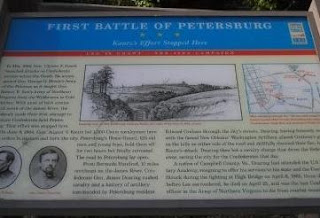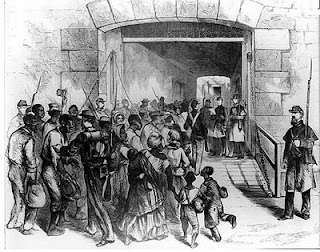* * * * * * * * * * * * *
Image of 54th Massachusetts Seige at Ft. Wagner
Several weeks ago in a weekday genealogy online chat, the Civil War Sesquicentennial came up in the conversation. The participation of the US Colored Troops was mentioned and the various regiments were brought up. One regular member made a comment that surprised me. "I wonder", he said, "how were so many men able to escape to Massachusetts to join the Union Army."
"What?" I asked him to repeat his statement, or to clarify what he was asking. He restated it, wondering how so many men who were slaves in the South, got to Massachusetts, during the war to join. I realized that this visitor, a regular to the chat and a long time family researcher, had no idea that the men who served in the US Colored Troops---were from the south, enlisted in the south, and fought in the south. They had to escape to get to the Union lines where the Federal soldiers were encamped, but why did he think they fled all the way to Massachusetts to enlist? He then started talking about the movie "Glory" and the 54th Massachusetts, and then I realized it. He had never studied the Civil War. Ever!
But, I began to think about how and why a man in his 60s had no concept of the Civil War, and the involvement of black soldiers, and why he was under the impression that there was only one regiment of black soldiers---and all were in the 54th Massachusetts, depicted in Glory! And I had a larger question----was he alone in this thinking? I thought about it----and sadly I realized that he was not alone and was not unique. The fact is---most African Americans have never studied the Civil War, nor relished many stories from the war----because the involvement of our own people in our own fight for freedom---is not widely known and has never been taught. The movie Glory, even with the many historical errors in the film----is the only movie to ever tell the story of black soldiers in the American Civil War.
So then I asked myself how many Civil War or Civil War era movies have been made in general?
I made a query on Google, and I was surprised that there were quite a few. Some of them went back to the beginning of the movie industry:
An Occurrence at Owl Creek Bridge
Andersonville
Drums in the Deep South
Gettysburg
Gettysburg Three Days of Destiny
Glory
Gods and Generals
Gone With the Wind
How the West Was Won
Major Dundee
North and South
Outlaw Josey Wales
Red Badge of Courage
Ride With the Devil
Shadow Riders
Shenandoah
The Birth of a Nation
The Blue and the Gray
The General
The Good, the Bad and the Ugly
USS Hunley
Wicked Spring
As I look at the list, two of them stand out in my mind. The Birth of a Nation was a film that did so much harm in the depiction of former slaves as intrinsically evil and a film that glorified the KKKlan and made them the "heroes" who saved the south. This film did so much harm to black families struggling in the South scraping a living as sharecroppers. It depicted them and their families as people deserving of being relegated to the mistreatment and lynchings of the era and made them "deserving" of any harm directed to them.
And there was Gone With the Wind, a movie I refused to watch until I was in my 40s and hated it for it represented---a glorification of slave owners and slave life with happy and simple minded slaves like Prissy. I continue to be amazed at how many people find that film to be such a wonderful love story when a major part of this country find it nauseating. With the other films---African American soldiers don't exist and were not participants in the war.
There have been documentaries in recent years that have included the involvement of US Colored Troops.
• Ken Burns, The Civil War (1990 Mini-Series PBS & Turner Home Entertainment)
• Civil War Journal II
After looking at that list and thinking about the man in the chat, I then began to think about another phenomenon.
Anyone who grew up in the south---knows---that just about every town, or at least every county seat has some kind of monument to confederate soldiers.
From an African American perspective, those monuments were simply one of the many indignities that life brought----monuments honoring slavery, the continuous us of that flag, the obstacles brought by segregation, and the hundreds of attacks upon innocent people usually with that flag being waved by angry mobs and so much more---it was just part of living in the south. But we had learned to just ignore the indignities and go about life.
At sporting events when the son Dixie was played we knew to just stay quiet while white people would cheer, get emotional and feel some kind of tie to a time that we were thanking our God that such time had passed. It was just part of life---expect the insults, for that is what they were, we ignored them and went on with more important issues at hand, for one's daily life.
But in recent years---thankfully in the years since more have had access to better education, the involvement of African Americans and the participation in the Civil War is now openly discussed and this discussion has created a new initiative to tell the story.
This has been enhanced by genealogical research that so many families have undertaken, and a new awareness has emerged because their own family was involved in the Civil War and they are documenting it!
Page from Pension File of Isaac Alexander, a soldier in the 79th US Colored Infantry
But then I reflected again on the conversation in the chat. The interest in US Colored Troops in the Civil War surged after 1989 when the movie Glory was released. A few years later, in 1998, the African American Civil War Monument was also unveiled.
African American Civil War Monument, Washington DC
Re-enactment groups have arisen over the years, many of which reflect the histories of specific regiments of US Colored Troops.
Images above: USCTs (left) Reenactor group from BennieMcCrae's website (right)
Of course this has been an uphill battle for just as quickly as USCT history has emerged, many fell victim to strong arm propaganda about mythical black confederate battalions that just did not exist. Anecdotes of loyal slaves are always shown as some kind of "proof" that these groups existed, but finally historians are expressing themselves more loudly against the myth makers and the message is getting through to the audience that needs to hear the simple fact that there were over 178,000 black men who fought for their own freedom, joined the Union Army to do so, and 16 Medal of Honors were awarded from their ranks.
I had to stop and think about that----16 Medals of Honor awarded, and most people cannot tell you the name of one man. This is not taught at all.
Headstone of William H. Barnes, one of 17 black Medal of Honor Winners in
the Civil War
I think that I was able to learn why we don't know more and how even slight USCT history is not common knowledge. I also realize that after the Civil War, when those who had seceded were given back their power and status and that of former slaves was legally made second class by Jim Crow, those black ex-soldiers were not able to freely celebrate their days of glory as victors in the war. Most lived in the only place they knew as home, and their victory and their post war years of celebration, would have made them easily targeted as they lived among those against whom they had been fighting.
Schools did not include black civil war soldiers in the curriculum, and black schools subject to inspection at anytime by a hostile school board, would not have tolerated stories of Union victories and bravery of black soldiers during those vulnerable post civil war and early 20th century years.
Also by being identified as Union soldiers in their local communities, they might have been targets for violence towards them and family, so they became silent heroes, or as a good friend and colleague has called them many times, "soldiers of silence."
In my Bass family in the 1880s that family was a victim of "night riders" who killed my gr. gr. grandfather. His son, my Uncle Sephus Bass, did get in some good shots and had to leave west for Texas where he did spend the rest of his life.
1879 Painting Depicting Klan Attack. My Bass Family was attacked by Klan night riders and my gr. gr. grandfather Irving Bass (father to Sephus Bass) was killed. Irving had two sons (Sephas and Braxton) and two grandsons, Henry and Emmanuel who served in the 111th US Colored Infantry together.
So many people to this day still do not know that they have ancestors who were Union Army veterans.
The good part of the story is that the numbers are increasing.These silent warriors deserve to be honored and to have their stories told.
I am happy to talk about them, call their names and to honor them.
We are here because of them. They are my heroes.
Certificate Verifying my Uncle Cephas (sic) Bass and his enlistment in 111th US Colored Infantry. His name is also engraved on the wall of the Afr. American Civil War Memorial in Washington DC.



























